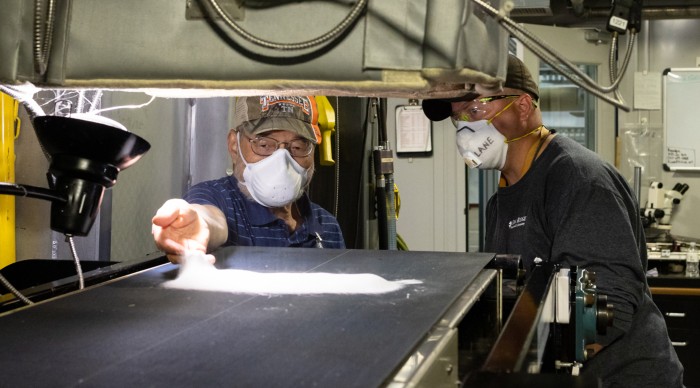Putting the charge back into face-mask filters
Peter Tsai, inventor of the electrostatically charged filter used in face masks, emerges from retirement to help boost filter production and reuse.
by Amber Dance
I spent my career working with microfibres, which have a diameter of 2 micrometres or so. Tangled mats of microfibres made of polypropylene are good materials for air filters — such as those in N95 respirators. They filter at least 95% of airborne particles and meet US National Institute for Occupational Safety and Health standards for medical use. In 1992, I invented a way to charge those filters by passing them through a device that produces static electricity — much like when you rub a balloon on your hair, but it’s permanent. The electrostatic charge makes the filters ten times better than uncharged filters at blocking viruses and other particles.
In this picture, I’m at the Oak Ridge National Laboratory in Tennessee, where I recently helped convert a system for making a precursor to carbon fibres into one that can produce and charge polypropylene filters for N95 masks. We melt the polypropylene and it’s extruded, like spaghetti. The extruder produces hundreds of fibres at once, then blows hot air at them so they tangle into a web as they land on the passing conveyer belt. Then they pass through the charging device — I gave them one I had.
The laboratory, which can now produce material for 9,000 masks an hour, aims to share the technology with other labs for research, and to train companies to make the material.
I retired in 2018, but have stayed busy, especially since the COVID-19 pandemic began and face masks became so important. People began to contact me because of the N95 shortage. They wanted to sterilize the masks for reuse without damaging them or destroying the electrostatic charge. I knew that heat would not alter the charge, but that alcohol would erase it. I experimented and learnt that ozone sterilization would retain the charge, but that ozone would crack natural rubber straps.
Even though I’m mostly working for free, I feel a responsibility to help out during the pandemic. Otherwise, I would regret it for the rest of my life.
Nature 585, 316 (2020)
doi: 10.1038/d41586-020-02550-8